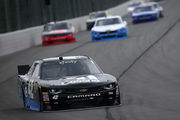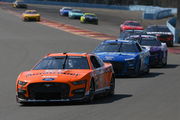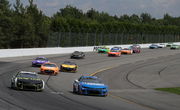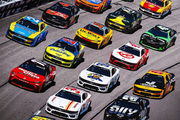
via Imago
NASCAR, Motorsport, USA Cup Qualifying Nov 5, 2022 Avondale, Arizona, USA NASCAR Cup Series driver Chase Elliott 9 speaks with NASCAR Cup Series driver Denny Hamlin 11 during qualifying at Phoenix Raceway. Avondale Phoenix Raceway Arizona USA, EDITORIAL USE ONLY PUBLICATIONxINxGERxSUIxAUTxONLY Copyright: xGaryxA.xVasquezx 20221105_gav_sv5_048

via Imago
NASCAR, Motorsport, USA Cup Qualifying Nov 5, 2022 Avondale, Arizona, USA NASCAR Cup Series driver Chase Elliott 9 speaks with NASCAR Cup Series driver Denny Hamlin 11 during qualifying at Phoenix Raceway. Avondale Phoenix Raceway Arizona USA, EDITORIAL USE ONLY PUBLICATIONxINxGERxSUIxAUTxONLY Copyright: xGaryxA.xVasquezx 20221105_gav_sv5_048
During the playoffs, every race is a compounded challenge for the drivers. The Round of 8 opener at the Las Vegas Motor Speedway was particularly challenging for NASCAR’s Golden Boy. NASCAR handed out a dramatic penalty to Chase Elliott, who is still in contention for the owner’s championship. After getting involved in a wreck during the qualifying, Elliott had to race in a backup car. To pile on to his woes, NASCAR penalized him for a laid-back restart. While this cost Elliott dearly, it was perhaps a triumphant moment for Denny Hamlin.
Hamlin has recently been vocal about stricter penalties on laid-back restarts, and finally, his persistence is paying off. The penalty sent Elliott’s hopes of championship glory plummeting, pushing him to eighth place in the owner’s standings—a whopping 61 points below the cut-line.
Elliott‘s teammate and driver of the #24 Chevrolet, recently shared his thoughts on NASCAR’s approach to laid-back restarts, and how this shift is affecting the racing landscape. In an interview with Bob Pockrass, Byron dived into this critical topic, shedding light on the NASCAR discussions and the challenges faced by drivers on restarts.
ADVERTISEMENT
Article continues below this ad
Even though it cost Chase Elliott dearly, William Byron is fine with NASCAR handing out restart penalties
As the race in Vegas reached its climax, Chase Elliott found himself in a challenging position. The late penalty left him finishing a lap down in 32nd place, earning a measly 5 points. Before this incident, Elliott sat proudly in second place on the owner’s championship table. However, the laid-back restart penalty had devastating consequences, pushing him down to eighth place, a whopping 77 points behind the leader. It was a significant setback for the #9 Chevrolet driver, and his championship dreams remain hanging by a thread.
William Byron offered a unique perspective on the recent penalties handed out for laid-back restarts. According to Byron, this topic has gained increasing prominence in NASCAR discussions since Denny Hamlin initiated the conversation after the race at Kansas Speedway.
In his own words, Byron highlighted the evolving nature of restart rules: “That’s something that has come up more in the last handful of weeks, I’d say since Denny said something at Kansas, really started to get on their radar about policing the restarts. I think it’s been needed for a little bit, I [have] already kind of adjusted. I think for the first time that Elton said something in the driver’s meeting. It was maybe a few weeks ago, I don’t remember where. But I started to pay attention to it and tried not to do it.”
Byron acknowledged the fine line drivers must tread during restarts. “It’s a fine line, you know, you can’t be right on the bumper of the guy in front of you because there are stack-ups and you don’t wanna get damage to your car. You try to stay within that window that is kinda appropriate by their standards. I feel like we’ve done a good job of restarting all year… I don’t know what our statistics [are] but I’m not too worried about it.”
Watch This Story | Kyle Petty Praises Goodyear Amidst Chase Elliott’s NASCAR Struggles
While NASCAR is now taking restart violations seriously, do the drivers have any clue what they’re precisely supposed to do during the restarts?
Trending
William Byron explains the restart situation from a driver’s perspective
As the discussion with William Byron continued, an essential question emerged. Do drivers truly understand the nuances of restarts? Byron provided valuable insights, emphasizing the differences between restarting at various positions on the track. The challenge is more significant when drivers are further back in the field. They need to maintain a more substantial gap to prevent collisions.
ADVERTISEMENT
Article continues below this ad
Byron explained, “I mean, it’s hard because when you’re further back in the field. The gap that you wanna have to not get checked up and not run into the guy in front of you is a lot bigger. When you’re upfront, just try to stay within that window of what you think is acceptable. I guess it’s all really subjective. But really just trying to stay within that reasonable space where you feel like it’s reasonable.”
And here’s William Byron’s thoughts on NASCAR penalizing drivers at Las Vegas for laying back on restarts: pic.twitter.com/HgyYqPdwm0
— Bob Pockrass (@bobpockrass) October 19, 2023
ADVERTISEMENT
Article continues below this ad
As drivers share their perspectives on restarts and the challenges they present, it becomes evident that mastering the art of restarting is a dynamic process. Understanding the nuances, maintaining a reasonable distance, and avoiding unfair advantages are all part of the strategy.
ADVERTISEMENT
ADVERTISEMENT
ADVERTISEMENT
ADVERTISEMENT






